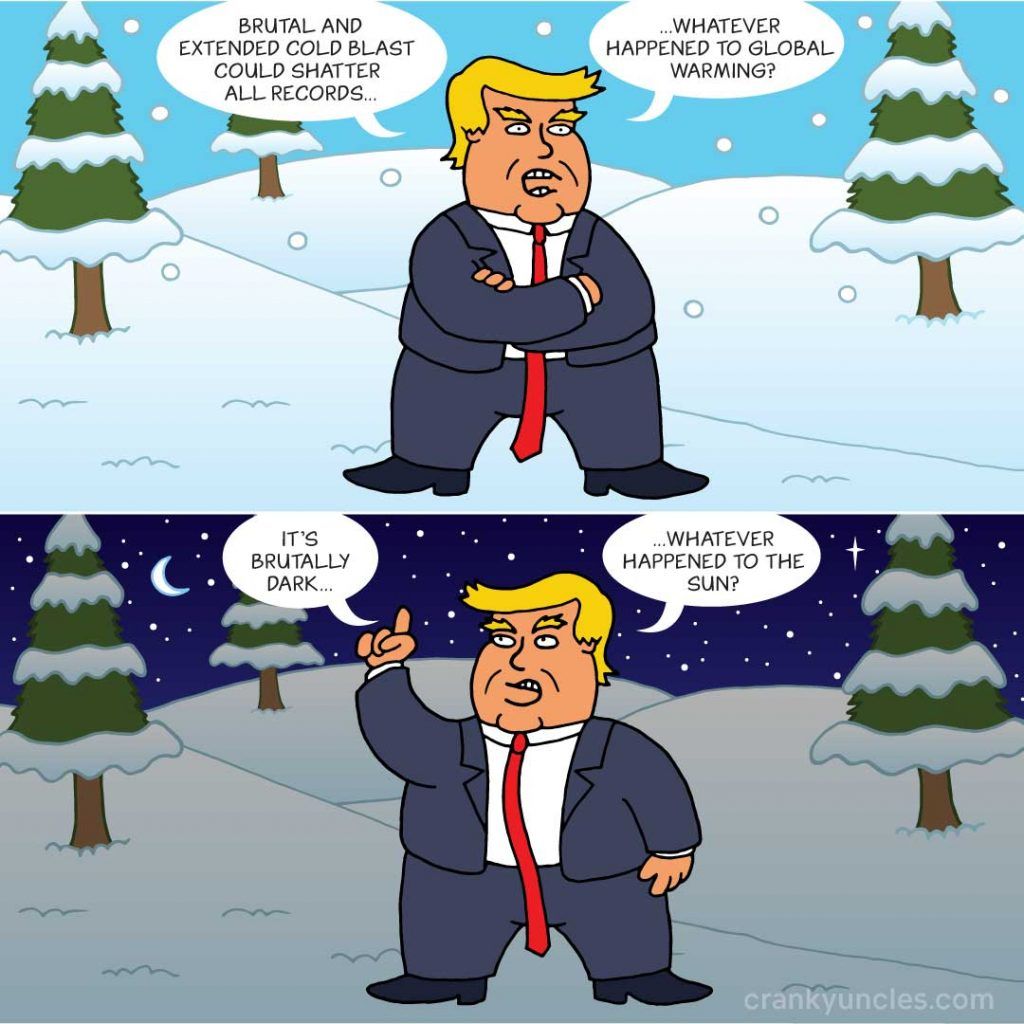Forecast: flurries of shivering climate-change deniers
By John Cook | January 29, 2019
 Image courtesy of John Cook of the Center for Climate Change Communication at George Mason University. Cook founded Skeptical Science, co-authored college textbooks on climate change denial, and developed the smartphone game Cranky Uncle using critical thinking and cartoons to counter climate misinformation. [See Cook’s original Bulletin article “Forecast: flurries of shivering climate-change deniers”]
Image courtesy of John Cook of the Center for Climate Change Communication at George Mason University. Cook founded Skeptical Science, co-authored college textbooks on climate change denial, and developed the smartphone game Cranky Uncle using critical thinking and cartoons to counter climate misinformation. [See Cook’s original Bulletin article “Forecast: flurries of shivering climate-change deniers”]
When a cold spell struck the east coast recently, US President Donald Trump tweeted “Wouldn’t be bad to have a little of that good old fashioned Global Warming right now!”
The argument he is sarcastically implying and often makes—that global warming isn’t happening because it’s cold outside—possesses an obvious logical flaw. It’s like arguing that the sun no longer exists when it gets dark at night. Of course, Trump didn’t invent this argument—it’s commonly brought up on denier blogs and social media threads whenever the weather turns cold.
Leaving the Arctic fridge door open. Typically, cold air is confined to the northernmost reaches of the globe by the polar vortex—swirling winds high above the Arctic. However, the polar vortex broke up into several smaller rings in early January. This is like leaving the fridge door open, letting cold air leak into the kitchen. Consequently, weather models are predicting harsh winter conditions in parts of the United States well into February. The country’s Northeast and Midwest will experience their coldest stretch of the year; CNN reported that 75 percent of the continental US population, or about 220 million people, “will endure below-freezing temperatures this week.”
My forecast for the next few weeks: Expect a flurry of climate-change deniers, shivering while they ask “whatever happened to global warming?!”
Of course, the argument that cold weather disproves global warming is not logical or scientific. Overall, the number of heat waves are increasing over time, while the number of cold snaps are decreasing. Across the United States, the number of times temperatures hit record highs over the last decade was double the number of times that temperatures sank to record lows. In a warming world, cold snaps don’t disappear entirely. They’re just less likely to occur.
But climate deniers don’t hold a monopoly on mistaking weather for climate. It’s human nature. Psychologically, our brains are structured to react to our immediate surroundings, and we’re more susceptible to experiential learning than scientific data. To demonstrate our immunity to abstract statistics, let me explain with some abstract statistics.
Daily weather drives climate attitudes. A number of scientific studies have explored how daily weather influences our attitudes toward climate change. One 2013 study published in Weather, Climate, and Society, for instance, examined a series of surveys measuring people’s agreement with the scientific consensus on human-caused global warming. One of the factors influencing climate attitudes was the temperature on the day of the survey and the previous day. On unseasonably warm days, people were more likely to agree with the scientific consensus that humans were causing global warming. On unusually cold days, not so much.
Further underscoring how our immediate environment influences our views on climate change, a 2012 study in the Journal of Environmental Psychology surveyed people’s climate attitudes while they were in a room with a dead plant. The scientists found that participants showed a higher belief in global warming compared to participants who filled out the same survey in a room with no plants. To confirm their conclusions, they then ran the same survey but this time with three dead plants. In this case, participants were even more likely to accept global warming. (As an aside, I’ve sometimes wondered whether my inability to keep plants alive might explain why I’m now so concerned about climate change.)
A number of studies confirm that daily weather and physical cues influence people’s views on climate change. However, there is an interesting wrinkle in the survey data. While overall, daily temperature influences people’s beliefs about climate change, that dynamic didn’t apply to everyone. In the United States, Democrats have a higher-than-average belief in climate change, while Republicans have a lower-than-average belief. But for both types of partisans, the daily weather had little influence on their attitudes. In the Weather, Climate, and Society study, all the movement happened among independents. On cold days, independents were much less accepting of climate change, but on hot days they were much more likely to believe the science.
In other words, partisans interpret incoming information, including weather conditions, through a partisan lens. Someone who is dismissive about climate change sees cold weather as proof that it is not happening, but downplays hot weather. Someone who is alarmed about climate change sees hot weather as supporting evidence, but doesn’t see cold weather as contradicting the science. Non-partisans are more influenced by weather fluctuations, one way or the other.
This insight helps answer a chicken-and-egg question: Do personal experiences of climate-related events shape people’s attitudes about climate change, or do people interpret climate events through the filter of their pre-existing beliefs? The answer is both, depending on whether you’re talking about partisans or non-partisans. People who are already highly engaged with the climate issue interpret climate events with motivated reasoning, that is, with a bias toward conclusions that conform to what they already know. In contrast, less engaged people are more influenced by personal experience of climate events (such as a perceived increase in extreme weather) than by their prior beliefs.
Consequences for communicators. This body of research has consequences for scientists and educators who engage with the public about climate change. Communication strategies that highlight local climate impacts have the potential to help people better understand how global warming is already affecting their lives. For example, TV weathercasters can place the events of the day—such as a hurricane or winter storm—within the long-term context of increasing frequency or intensity. Similarly, public health professionals can help draw attention to the local health impacts of climate change, such as heat stress or air pollution. Local events and impacts can be used as teachable moments in order to make the statistical abstraction that is climate change more concrete.
Of course, connecting the dots between weather-related events and global warming needs to be done in a scientifically accurate way, helping people to properly understand how the events we experience are being influenced by a changing climate. Climate communicators have to navigate the tension between a scientifically robust way of thinking and how the average person actually thinks. This includes making sense of contrary events such as cold weather, which will continue in a warming world, but at a declining rate.
Together, we make the world safer.
The Bulletin elevates expert voices above the noise. But as an independent nonprofit organization, our operations depend on the support of readers like you. Help us continue to deliver quality journalism that holds leaders accountable. Your support of our work at any level is important. In return, we promise our coverage will be understandable, influential, vigilant, solution-oriented, and fair-minded. Together we can make a difference.
Keywords: climate change, climate change communication, popular culture
Topics: Climate Change, Columnists














